|
When you look at a United States map and see a dot
called Port Townsend way off there in the upper left hand corner or if you
read a December 2007 news item about how the sudden retirement of four
Washington State ferries left Port Townsend cut off from the rest of
civilization, you might wonder why on earth Chris Knutsen would choose
such a remote outpost to start his harp guitar business.
It wasnít remote.
In the time Chris lived there, 1888 to 1892 and
1895-1900, Port Townsend was served by a number of steamboats that plied
between Olympia at the south end of Puget Sound and Victoria on Vancouver
Island across from the northern entrance to the Sound. As the crow flies,
Port Townsend and Olympia are about 70 miles apart, and itís about 40
miles to Seattle. Those routes included Seattle, Tacoma, Everett,
Bellingham, and Vancouver (B.C.) among the many population centers.
Furthermore, Port Townsend had the custom house where all boats entering
Puget Sound had to stop and declare themselves, so the town itself was a
major commercial hub.
|
This map of Puget Sound
shows its major towns with Port Townsend, where Chris Knutsenís home
was in the 1890s, overlooking its entrance. It is 45 miles (by
water) from
Port Townsend to Seattle, and another 28 miles from Seattle to
Tacoma. Vancouver is just off the map on the mainland shore 50
miles northeast of Victoria. While these distances do not seem great
today, even a fast steamboat only traveled about 15 mph and this
coupled with frequent stops at communities along the way could make
the trip take a half-day to a day. |
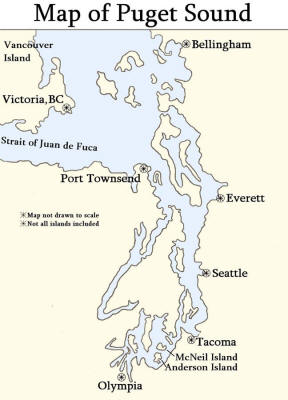 |
Other transportation was not an option. For
instance, Port Townsend wanted to be a major railroad terminal even after
Northern Pacific awarded the honor to Tacoma in 1873. Supporters of a
northern extension of the railroad from Portland to Port Townsend held out
hope well into the early 1900s, but the developers ran out of money and
the boom economy of Port Townsend faded. By 1900 rumors of the railroad
extension remained just thatórumors. Today the roadbeds that were built in
anticipation lie rotting in the rainforest undergrowth.
However, steamboats made their entrance onto the
Sound in 1853 and until the 1920s when the escalating shift to car ferries
spelled their doom, they were the most convenient and comfortable way to
get around. In the absence of roadsówhich were hard to build in dense
forests choked with undergrowthócommunities grew up where rivers flowed
into the Sound and provided easy access for boats. Port Townsend has a
superb deep harbor.
Until 1900 there were several steamboats whose
services Chris might have used, though there is no way of knowing for sure
which ones he patronized.
| To name just a few, one contender was the Geo. E.
Starr. A side-wheeler built in Seattle in 1879, she ran ten years on
the Olympia-Victoria route. With Chrisís arrival in the Northwest in late
spring 1888, this is a boat he could have taken to Port Townsend. In the
1890s, she plied between Tacoma, Seattle, Port Townsend and Vancouver and
was the last side-wheeler operating on the Sound when she retired in 1911. |
|
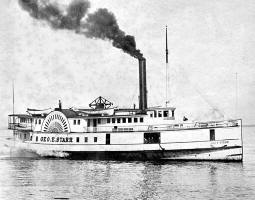 |
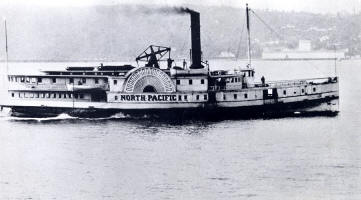 |
|
Another side-wheeler, the North Pacific, ran from Olympia
to Victoria from the 1870s until she struck rocks off Marrowstone
Point near Port Townsend and sank in 1903 (all passenger were safe).
This is another boat he could have traveled on. |
|
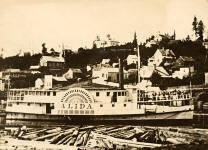
|
|
The Alida, also a side-wheeler, was built in
1869 for the Olympia-Victoria mail route, but she could not handle the
rough water in the Strait of Juan de Fuca, so ran from Olympia to Port
Townsend twice a week until she burned in 1890. |
|
The City of Kingston, a steel-hulled
propeller, served the international run, Tacoma to Victoria, from 1890
until she was rammed in a heavy fog near Tacoma and sank in 1899 (everyone
was rescued).
|
|
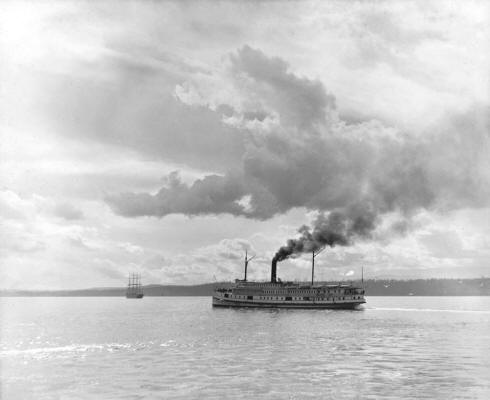 |
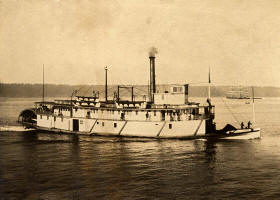 |
|
I like to think that Chris might have ridden the
handsome Multnomah if he had business in south Puget Sound. She
had a dining room with white linen cloths and the flower bouquets were
picked by my grandmother, Bessie Johnson, when the boat stopped for fuel
at Johnsonís Landing on Anderson Island. |
| Johnsonís Landing lies on the north side of Anderson Island
looking across Balch Passage at McNeil Island in the background.
The small island between is called Eagle and is uninhabited. Here
the sternwheeler Northern Light is pulled up to the dock for
refueling with cordwood. Chris probably came to this steamboat stop
when visiting his uncle Hans Kammen in south Puget Sound and perhaps
went to a party here at the Johnsonís.
(Photo courtesy of Anderson Island
Historical Society) |
|
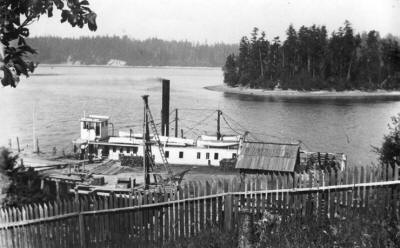 |
In looking at the information on Knutsen instruments,
there is usually not enough known about the provenance to say for sure
where Chris originally sold an instrument. We can tell where an
instrument was built because the time period can be ascertained.
HGS63 has a provenance that suggests Chris had a shop
in Bellingham. I do not find evidence of that, yet. There is no listing
of Chris in either a residence or a business in Bellingham in 1911, 1912,
or 1913. My guess is Chris went to Bellingham, probably by steamboat, and
made a sale while he was there. It is thrilling to have the specific
date, April 29, 1912, that this instrument was sold by Chris, but so far
it doesnít help place him there in any permanent fashion.
What I can speak about with authority is my own harp
guitar, given to me by my uncle, Bob Cammon, HGP9. It has always been in
my family, though how that came to be involves a certain amount of
guesswork.
My great-grandfather, Hans Kammen, was Chris
Knutsenís uncle. Hans and his family moved from North Dakota, where they
lived near Chrisís father and mother, Ole Ferdinand and Bergitte Cammon,
to McNeil Island, south of Tacoma, in 1887. Chris and Anna and Annaís
parents, Anton and Edwardina Cammen (Anton was an older brother to Hans
and Ole Ferdinand) moved to Port Townsend in 1888. The first stay was
brief as they all returned to Minnesota in 1892. Chrisís father-in-law
died in Minnesota in 1895 and at that time he with his wife Anna, two
daughters Bertha and Evaulda, and mother-in-law Edwardina returned to Port
Townsend.
I think Chris and perhaps his family came south to
visit his Uncle Hans. His steamboat would have stopped at Johnsonís
Landing on Anderson Island where it picked up cordwood to fuel the
engine. Naturally Chris would have gotten off.
This stop, the woodyard that sold fuel to steamers,
was owned by my great-grandfather, Bengt Johnson. His daughter, my
grandmother Bessie Johnson, would marry Hanís son Oscar Cammon, in 1906.
In the meantime, my grandfather owned a small steamboat (less than 50 feet
long, a size called a launch) and did all sorts of odd jobs carrying
passengers, shrimping, and anything anyone would pay him to do. Picking
up his cousin at a dock only a mile or so from his home would be easy. McNeil and Anderson Islands lie about a quarter-mile
apart on either side of Balch Passage. In those days the populations of
both islands often got together for socials. People could row over or
come in a larger boat. They had a big meal. They made taffy. They would
gather in the parlor around the organ or piano and sing. Maybe someone
would play fiddle with the piano for the people to dance. My maternal
great-grandparents often hosted these occasions which lasted into the wee
hours and were great fun. I suspect the occasion of Chris visiting and
bringing his new instrument, the harp guitar, provided the impetus and the
entertainment for one of these get-togethers. That Chris sold the guitar
off his back to my Grandma Bessieís parents would be just what Chris would
do. The note with the instrument, in my grandmotherís handwriting, says
her parents bought the harp guitar about 1900. In 1906, when my
grandparents married, the guitar came back into its creatorís family.Even after Chris shifted his business to Tacoma in
1900 and then to Seattle before moving to Los Angeles around 1915,
steamboat remained the best way to travel on Puget Sound and indeed, even
down the coast to all points between Seattle and San Diego. It is
possible that when Chris moved south he went by steamboat and not train. |